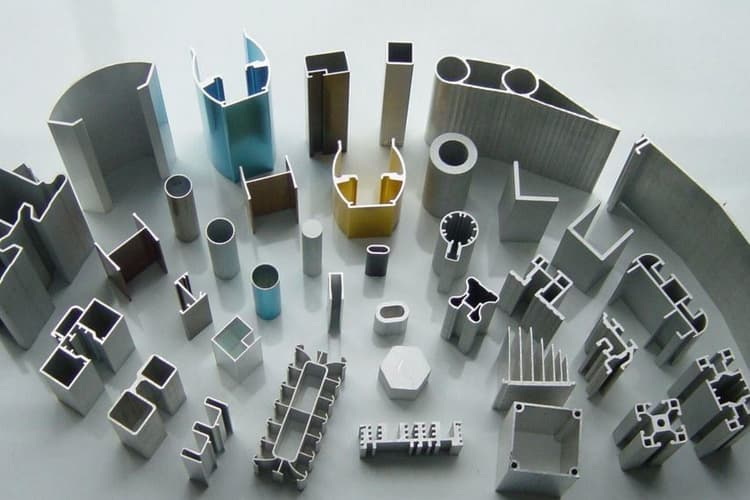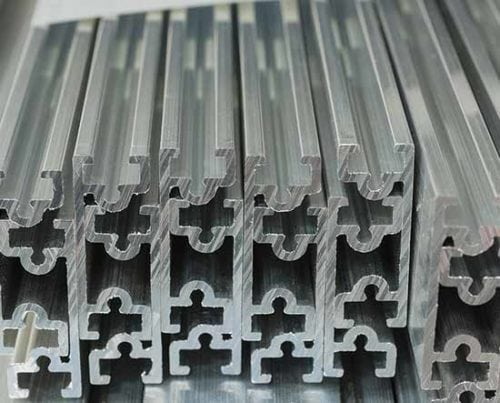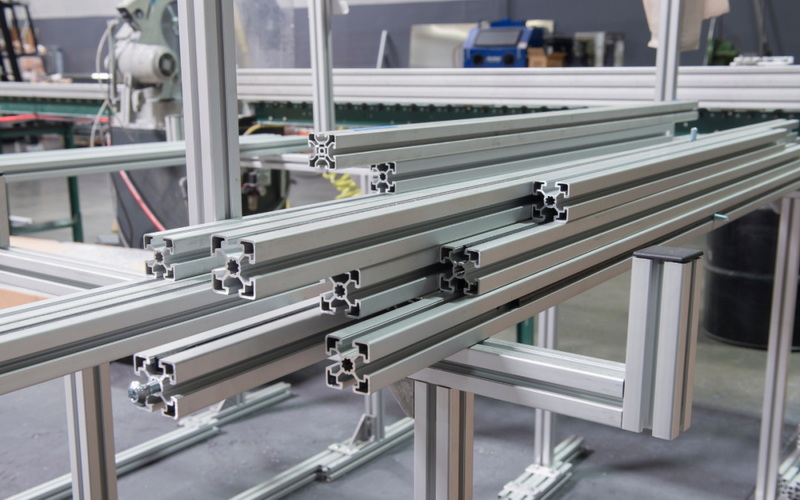Content Menu
● Understanding Aluminum Extrusions
● Benefits of Using 1 x 1 Aluminum Extrusions
● Best Applications for 1 x 1 Aluminum Extrusions
>> Structural Framing
>> Automotive Applications
>> Architectural Applications
>> DIY Projects
>> Industrial Applications
>> Electronics and Technology
● Working with 1 x 1 Aluminum Extrusions
● Conclusion
● Frequently Asked Questions
>> 1. What is the weight capacity of a 1 x 1 aluminum extrusion?
>> 2. Can I customize 1 x 1 aluminum extrusions?
>> 3. What tools do I need to work with aluminum extrusions?
>> 4. Are aluminum extrusions suitable for outdoor use?
>> 5. How do I join aluminum extrusions together?
Aluminum extrusions are a versatile and widely used material in various industries due to their lightweight, strength, and corrosion resistance. Among the different sizes and shapes available, the 1 x 1 aluminum extrusion is particularly popular for its adaptability and ease of use. This article explores the best applications for 1 x 1 aluminum extrusions, highlighting their benefits, common uses, and practical tips for working with them.

Understanding Aluminum Extrusions
Aluminum extrusion is a manufacturing process that involves shaping aluminum alloy by forcing it through a die. This process allows for the creation of complex cross-sectional shapes that can be tailored to specific applications. The 1 x 1 aluminum extrusion typically refers to a square profile with dimensions of one inch by one inch, making it ideal for a variety of structural and aesthetic applications.
Benefits of Using 1 x 1 Aluminum Extrusions
1. Lightweight: Aluminum is significantly lighter than steel, making it easier to handle and transport. This characteristic is particularly beneficial in applications where weight is a critical factor, such as in aerospace and automotive industries.
2. Strength and Durability: Despite its lightweight nature, aluminum is strong and can withstand significant loads. The 1 x 1 aluminum extrusion can support various structures without compromising integrity.
3. Corrosion Resistance: Aluminum naturally forms a protective oxide layer that helps prevent corrosion. This property makes it suitable for outdoor applications and environments where moisture is present.
4. Versatility: The 1 x 1 aluminum extrusion can be used in numerous applications, from framing and supports to decorative elements. Its adaptability allows it to fit into various design requirements.
5. Ease of Fabrication: Aluminum extrusions can be easily cut, drilled, and assembled, making them user-friendly for DIY projects and professional applications alike.
Best Applications for 1 x 1 Aluminum Extrusions
Structural Framing
One of the most common applications for 1 x 1 aluminum extrusions is in structural framing. These extrusions can be used to create lightweight frames for various structures, including:
- Workstations: Custom workstations can be built using 1 x 1 aluminum extrusions, providing a sturdy yet lightweight solution for industrial and office environments. The modular nature of these extrusions allows for easy reconfiguration as needs change.
- Shelving Units: The strength of aluminum allows for the construction of shelving units that can hold significant weight while remaining easy to assemble and disassemble. This is particularly useful in warehouses and retail environments where flexibility is key.
- Display Stands: Retailers often use aluminum extrusions to create attractive display stands that are both functional and visually appealing. The clean lines and modern aesthetic of aluminum can enhance product visibility and customer engagement.
Automotive Applications
The automotive industry has increasingly turned to aluminum extrusions for various components due to their lightweight and strength. The 1 x 1 aluminum extrusion can be used in:
- Chassis Components: Many modern vehicles utilize aluminum extrusions in their chassis to reduce weight and improve fuel efficiency. This shift not only enhances performance but also contributes to lower emissions.
- Interior Structures: Aluminum extrusions can be used to create lightweight interior components, such as seat frames and dashboard supports. This helps manufacturers meet stringent safety and performance standards while maintaining a sleek design.
- Body Panels: Some manufacturers use aluminum extrusions for body panels, providing a sleek look while maintaining structural integrity. The use of aluminum in body construction is becoming more common as manufacturers seek to improve fuel efficiency and reduce overall vehicle weight.
Architectural Applications
In architecture, 1 x 1 aluminum extrusions are often used for both structural and decorative purposes. They can be found in:
- Window Frames: Aluminum extrusions provide a durable and lightweight option for window frames, enhancing energy efficiency and aesthetics. The ability to create custom shapes and sizes allows architects to design unique window configurations.
- Railings and Fencing: The strength and corrosion resistance of aluminum make it an excellent choice for railings and fencing in residential and commercial properties. These features ensure longevity and minimal maintenance, making aluminum a cost-effective choice over time.
- Canopies and Awnings: Aluminum extrusions can be used to create canopies and awnings that are both functional and stylish, providing shade and protection from the elements. The lightweight nature of aluminum allows for larger spans without the need for excessive support structures.

DIY Projects
For hobbyists and DIY enthusiasts, 1 x 1 aluminum extrusions offer endless possibilities. They can be used in:
- Robotics: Many robotics projects utilize aluminum extrusions for building frames and supports due to their lightweight and strength. The modular design allows for easy adjustments and modifications as projects evolve.
- Model Building: Model builders often use aluminum extrusions to create detailed and sturdy structures for their projects. The precision of aluminum extrusions ensures that models are both accurate and durable.
- Furniture Design: Custom furniture pieces can be designed using aluminum extrusions, allowing for unique and modern designs. The ability to combine aluminum with other materials, such as wood or glass, opens up a world of creative possibilities.
Industrial Applications
In industrial settings, 1 x 1 aluminum extrusions are commonly used for:
- Conveyor Systems: Aluminum extrusions can be used to create lightweight and durable conveyor systems that facilitate the movement of goods. Their modular nature allows for easy reconfiguration to adapt to changing production needs.
- Machine Frames: Many machines are built using aluminum extrusions, providing a strong and stable base for various operations. The ability to customize the frame design ensures compatibility with specific machinery requirements.
- Safety Guards: Aluminum extrusions can be used to create safety guards and barriers in industrial environments, ensuring worker safety. The lightweight nature of aluminum makes it easy to install and relocate as needed.
Electronics and Technology
The electronics industry also benefits from the use of 1 x 1 aluminum extrusions. They can be found in:
- Heat Sinks: Aluminum's excellent thermal conductivity makes it ideal for heat sinks in electronic devices, helping to dissipate heat effectively. This is crucial for maintaining optimal performance and extending the lifespan of electronic components.
- Enclosures: Many electronic devices use aluminum extrusions for their enclosures, providing protection while maintaining a lightweight design. The ability to create custom enclosures allows for better integration of components and improved aesthetics.
- Mounting Systems: Aluminum extrusions can be used to create mounting systems for various electronic components, ensuring stability and ease of access. This is particularly important in applications where frequent maintenance or upgrades are required.
Working with 1 x 1 Aluminum Extrusions
When working with 1 x 1 aluminum extrusions, there are several tips to keep in mind to ensure successful projects:
1. Cutting: Use a miter saw or band saw with a fine-toothed blade to achieve clean cuts. Always measure twice before cutting to avoid mistakes. Proper cutting techniques will ensure that the extrusions fit together seamlessly during assembly.
2. Drilling: Use a drill with a high-speed steel bit to create holes for fasteners. Ensure the extrusion is securely clamped to prevent movement while drilling. This will help maintain accuracy and prevent damage to the material.
3. Assembly: Utilize T-nuts and bolts for easy assembly and disassembly. This allows for flexibility in design and modifications as needed. The use of T-nuts also enables quick adjustments without the need for specialized tools.
4. Finishing: Consider anodizing or powder coating the aluminum extrusions for added protection and aesthetic appeal. This can enhance the durability and appearance of your project, making it more resistant to scratches and corrosion.
5. Safety: Always wear safety goggles and gloves when working with aluminum extrusions to protect against sharp edges and debris. Proper safety precautions will help prevent injuries and ensure a safe working environment.
Conclusion
The 1 x 1 aluminum extrusion is a versatile and valuable material used across various industries and applications. Its lightweight, strength, and corrosion resistance make it an ideal choice for structural framing, automotive components, architectural designs, DIY projects, industrial applications, and electronics. By understanding the best applications for 1 x 1 aluminum extrusions and following best practices for working with them, you can unlock their full potential in your projects.

Frequently Asked Questions
1. What is the weight capacity of a 1 x 1 aluminum extrusion?
The weight capacity depends on the specific design and application, but generally, 1 x 1 aluminum extrusions can support significant loads when properly supported. Factors such as the length of the extrusion and the type of load (static or dynamic) will influence its capacity.
2. Can I customize 1 x 1 aluminum extrusions?
Yes, many manufacturers offer customization options for aluminum extrusions, allowing you to tailor them to your specific needs. Customization can include different lengths, finishes, and even unique shapes to fit specialized applications.
3. What tools do I need to work with aluminum extrusions?
Basic tools include a miter saw, drill, clamps, and fasteners. Additional tools may be required depending on the complexity of your project. Having the right tools will ensure a smoother workflow and better results.
4. Are aluminum extrusions suitable for outdoor use?
Yes, aluminum extrusions are corrosion-resistant and can be used in outdoor applications, making them ideal for various environmental conditions. However, it is advisable to consider additional protective coatings for prolonged exposure to harsh elements.
5. How do I join aluminum extrusions together?
You can join aluminum extrusions using T-nuts and bolts, corner brackets, or welding, depending on the strength and design requirements of your project. Each method has its advantages, so choose the one that best fits your specific application and desired aesthetics.






















